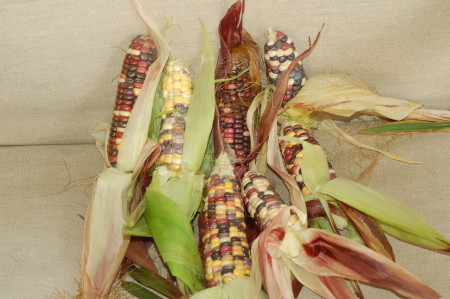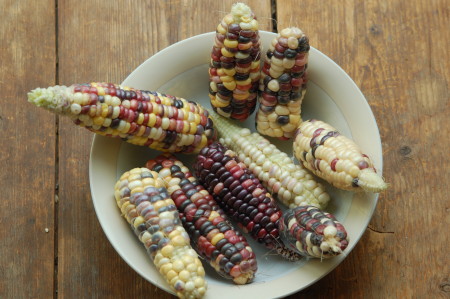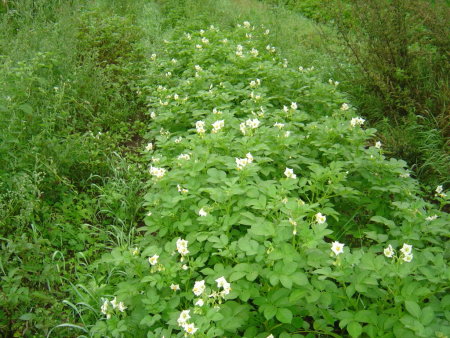
This was one of my most anticipated harvests of the season, my Painted Hills Sweet corn. There is a well known variety of starch corn called Painted Mountain, a genepool mix of a number of different colored heirloom varieties. This was a cross between that variety and Luther Hills Sweet Corn. The seed for this came from Peace Seedlings, the seed company belonging to the daughter of Alan Kapuler, who was the breeder of this variety.
Watching the plants grow was a blast! All different colors; stalks, silk, ears and of course the kernels. It was like a fantasy land crop, almost too colorful to believe it was real. You can see a lot of the colors in the picture above.

With all the excitement came some disappointments too. First I had damping off problems when starting the seeds indoors and lost more than half my seedlings. Okay, damping off problems were probably my fault for not keeping things clean enough, but I did try to keep things clean and didn’t have any damping off problems with any other seeds.
Then when I put them out in the garden, a number of them were too weak to survive. Again, this could be partly my fault, and perhaps I could have let them get bigger before setting them out or maybe I could have waited for the soil to warm up a little more.
Then there was a lot of variability in the remaining plants, and it’s clear the genetics were not completely there for my climate. Really, they didn’t grow well at all. I struggled to get a decent harvest, and it’s mostly what you see in the picture above (starting with 125 seeds). I might get a few more ears in a few weeks time. I had a hard time telling when it was mature enough to harvest, because the ears were small and underdeveloped so I kept thinking I should give it more time.
The taste?
I had high expectations. I had very, very high expectations, and they simply weren’t met. I ate it about an hour after harvest, so it was very fresh, but it was not at all sweet. I understand heirloom sweet corn is not as sweet as commercial varieties, but still this didn’t even have any hint of sweetness. Mostly it was starchy and bland. It was however very edible in it’s own way.
Was I disappointed?
Well, a little. Like I said, I expected so much more. At the same time, wow! Multi-colored sweet corn! Can you believe it? A variation of the famous Painted Mountain corn! Perfectly edible. Truly a visual delight, if not a tasty one. It’s clear it needs some breeding and selection work to make it suitable for my climate and to stabilize it, something I don’t have the space, isolation, expertise or time for right now. If this is an early peek at the future of sweet corn, it’s exciting! It needs some work, but this really has the potential to turn into a very interesting variety!
Will I Grow it Again?
Not anytime soon. I’ve seen it and done it, and will look for something else next year. Trying it was a great experience.





